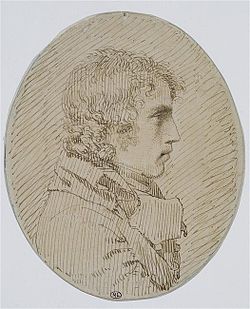Top Qs
Timeline
Chat
Perspective
Pierre-Paul Prud'hon
French painter From Wikipedia, the free encyclopedia
Remove ads
Pierre-Paul Prud'hon (French pronunciation: [pjɛʁ pɔl pʁydɔ̃], 4 April 1758 – 16 February 16, 1823) was a French Neo-classical painter and draughtsman best known in his own time for his allegorical paintings and portraits, now for his drawings. He painted a portrait of each of Napoleon's two wives.
This article includes a list of general references, but it lacks sufficient corresponding inline citations. (February 2025) |
You can help expand this article with text translated from the corresponding article in French. (22 January 2025) Click [show] for important translation instructions.
|
He was an early influence on Théodore Géricault. After 1803 he worked so closely with artist Constance Mayer on many paintings, that it is almost impossible to tell where the contribution of one ends and the other begins.[1]
Remove ads
Biography
Summarize
Perspective

Pierre-Paul Prud'hon was born in Cluny, Saône-et-Loire, France. He received his artistic training in the French provinces He married Jeanne Pennet in 1778 in Cluny. They had six children.[3]He went to Italy when he was twenty-six years old to continue his education.
In Paris he became an enthusiastic supporter of the Revolution and made drawings of mythological and republican allegories which were engraved and published by his friend Jacques-Louis Copia.[4]
Prud’hon made some portraits during this period including one of Louis de Saint-Just, one of the key figures in the Reign of Terror.[5]
At the fall of Robespierre,in 1794, Prud’hon found it prudent to leave Paris. He spent two years in Franche-Comte, painting portraits and making book illustrations.
In 1796, it was safe to return to Paris. He decorated rooms in some private mansions with allegories of art, philosophy, wealth, and pleasure.[6]
Prud’hon’s Portrait of Empress Josephine shows her alone in the garden of her home, Malmaison.[7]After the divorce of Napoleon and Josephine, he was also employed by Napoleon's second wife Marie-Louise.
Prud'hon was at times clearly influenced by Neo-classicism, at other times by Romanticism. He was appreciated by other artists and writers, including Stendhal, Delacroix, Millet and Baudelaire, for his chiaroscuro and convincing realism. He painted Crucifixion (1822) for St. Etienne's Cathedral in Metz; it now hangs in the Louvre.
The young Théodore Géricault had painted copies of work by Prud'hon, whose "thunderously tragic pictures" include his masterpiece, Justice and Divine Vengeance Pursuing Crime, where oppressive darkness and the compositional base of a naked, sprawled corpse obviously anticipate Géricault's painting The Raft of the Medusa.[2]
Remove ads
Gallery
- Male Nude Study, National Gallery of Art
- Portrait of Louis de Saint-Just, 1793
- Nicolas Perchet, 1795, Princeton University Art Museum
- Female Nude, 1800
- Portrait of Charles Maurice de Talleyrand-Périgord, 1817
- Study for The Dream of Happiness (with Constance Mayer), 1819
References
Further reading
External links
Wikiwand - on
Seamless Wikipedia browsing. On steroids.
Remove ads









